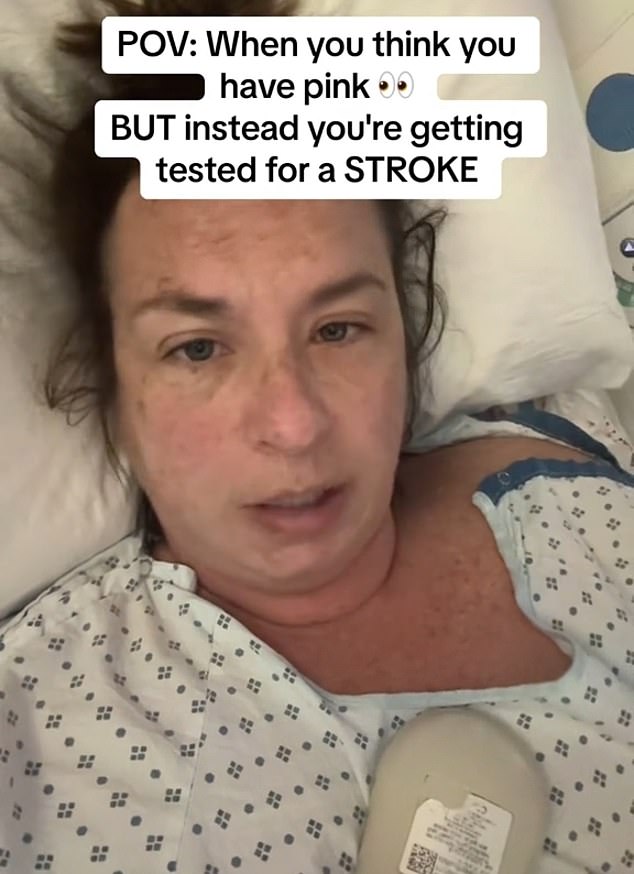A woman who thought she had pink eye actually suffered a ‘functional’ stroke
A woman who thought she had pink eye actually had a stroke.
Nicole Lamoureux, 51, a business influencer on TikTok, thought she was having an allergic reaction when her eyelid swelled and turned pink last week.
As she drove to the hospital with her husband, her arms began to shake and her speech became much slower.
Doctors told her she had suffered a “functional stroke,” which was caused by abnormal functioning of the nervous system rather than damage to the brain.
Nicole Lamoureux, 51, a business strategy influencer, thought she was having an allergic reaction when her eyelid swelled and turned pink

Doctors told her she had suffered a functional stroke, also called a “stroke mimic,” in which there is a problem with the way the brain sends and receives information to the rest of the body.
“My brain can’t connect very well to my other limbs,” she said in a TikTok video viewed by more than 1.3 million people.
FND can start without warning and affects the way the brain and body send and receive signals between them.
Unlike a stroke, which shows up in specific areas on brain scans, FND affects the brain’s messaging mechanisms that aren’t visible in this way, meaning FND is too often overlooked by medical professionals, experts say.
The symptoms of a functional neurological disorder (FND) are real and are caused by a problem with the brain’s messaging capabilities.
For example, people may not be able to send a message to their legs to make them move, even though a scan may not show any damage to the legs or brain.
This is why patients with FND are often discharged and told that their symptoms are ‘all in their heads’.
FND can include a wide range of neurological symptoms, such as limb weakness or seizures.
Nicole took to TikTok to warn her 44,000 followers not to ignore unexplained symptoms and get them checked by a doctor.
Pinkeye, the inflammation or infection of the outer membrane of the eyeball and inner eyelid, is usually caused by a viral infection. It can also be caused by a bacterial infection or an allergic reaction.
The first stroke-like symptoms, such as swelling of the face and difficulty seeing in one eye in Nicole’s case, are likely due to physiological arousal, according to the Journal of Neuropsychiatry.
This can, for example, be caused by stress and cause migraines.

Nicole Lamoureux, a business strategy influencer, is also president and CEO of the National Association of Free and Charitable Clinics
Panic and anxiety “cause further automatic arousal, which worsens the initial symptoms,” according to the Journal.
Niccole now has limited mobility in her right leg and “sometimes my right arm doesn’t work either,” she said.
Limb weakness may occur due to an “abnormal prediction of weakness… at different levels of the motor control pathway.”
In other words, patients expect that their leg and arm will not move, and that does not happen.
In a TikTok video, Nicole can be seen dragging her right leg while using a walker to try to walk.
Symptoms of FND may include loss of motor control, sensory symptoms, speech problems, seizures, visual symptoms, cognitive problems, and bladder and bowel problems.
FND affects approximately 12 out of 100,000 individuals.
The exact cause of FND is unknown. Sometimes FND occurs after a stressful event or in people with a history of emotional or physical trauma.
When stress pathways are activated, there is an increase in cortisol levels and an enzyme called α-Amylase, which takes its toll on the body. Research suggests that chronic activation of stress pathways can lead to the onset of symptoms.
“Physiological responses to stress can become a conditioned response, and over time the threshold for the physiological response decreases until symptoms emerge in response to minor stressors or even the memory of an event,” researchers wrote in the Journal of Neuropsychiatry.
Nicole said she had a “huge migraine” just before the stroke, and she thought it was pink eye and swelling in her face.
“I’ve been under tremendous stress over the last few years,” she said.
“Please put your safety and self-care first. Remember to take care of yourself and not put the needs of others before your own,” Nicole added.
Treatment for FND includes physical therapy and speech therapy to improve the patient’s symptoms.
“If you wake up and think you have pink eye … and you’re given medicine for pink eye, but it’s not pink eye, you go to the hospital,” she said.
